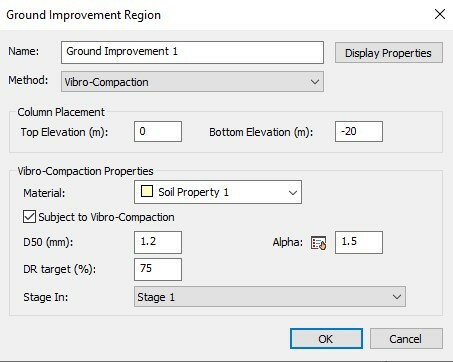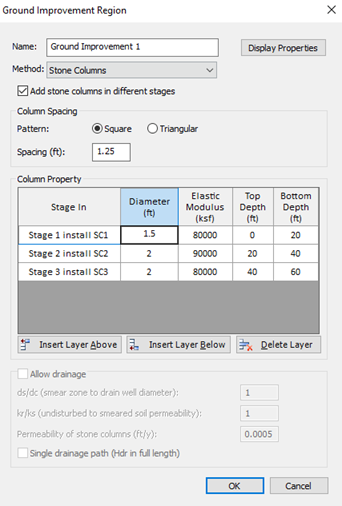Ground Improvement
Ground improvement regions can be added to the model using the Soils > Add Region (Ground Improvement)  option. In the Ground Improvement Region dialog, the following four methods are available:
option. In the Ground Improvement Region dialog, the following four methods are available:
- Soil Replacement
- Vibro-Compaction
- Stone Columns
- Dynamic Compaction
The user must select one of these three methods to implement as a ground improvement region. The use is not limited to just one region; If multiple ground improvement regions are defined, they may simultaneously be edited in the Ground Improvement Region Editor (accessed through the Soils > Ground Improvement tab).
After selecting the ground improvement method, the user will be responsible for inputting specific parameters allocated for each method and finally defining the boundaries. Material properties belonging inside the boundaries are considered in the ground improvement computations and those outside of the ground improvement region remain unchanged.
Soil Replacement
Soil Replacement is a straightforward method for improving in-situ soil properties; the soil is simply replaced by another material. The user is asked to input the following parameters:
- Top Depth
- Bottom Depth; and
- Soil Property
The user must select a material from the dropdown menu next to Soil Property. This is the material with which the in-situ soil will be replaced. In theory, the elastic modulus of the existing soil is replaced by the new material's elastic modulus. To improve the soil's total settlement it should be noted that if the user replaced the soil with a material of a lower elastic modulus, the settlement would in fact be increased creating the opposite effect.
The Top Depth and Bottom Depth are simply the elevations of the replacement material within the in-situ soil model.
Advanced Staging
To define a more complex ground improvement scenario, check the Advanced option, and you can apply different improved materials in different stages and depths.
Vibro-Compaction
Vibro-Compaction is a ground improvement technique that is primarily used with sandy soils. Since the mechanism depends on the vibratory equipment energy to shake the granular material to fill voids, this technique is not effective on cohesive soils and some silty sands. Bauman and Bauer created a design chart to help select the best ground improvement option depending on the grain size distribution of the soil sample.

The user is asked to input the material which needs to be vibro-compacted by checking the Subject to Vibro-Compaction option shown below:

In addition, the following input parameters are required for Settle3 to compute the settlement analysis:
- mean grain size (mm)
- target relative density (%); and
- coefficient alpha
The mean grain size, also known as D50, is the average grain size in a soil sample.
The target relative density, DR, is the relative density of the sand after it has been vibro-compacted. It is referred to as 'target' relative density because it is the density by which the vibro-compaction process aims to achieve.
The coefficient alpha, α, is a coefficient that is dependent on the type of sand that is being vibro-compacted. Values for alpha can vary, and the following have been taken from Principles of Geotechnical Engineering by Braja M. Das to depict typical values for alpha:
- 5 for sands with fines
- 10 for clean sands but normally consolidated
- 15 for clean sands but overconsolidated
TIP: To model a more complex ground improvement scenario, the user can specify the exact stage they want the vibro-compaction to be considered.
Stone Columns
Stone Columns were first introduced approximately 60 years ago as a technique for improving both cohesive soils and silty sands. Its construction involves the partial replacement of unsuitable soils with a pattern of compacted vertical columns of stone. The most widely used patterns of stone column replacement are the square pattern(left) and the triangular pattern(right), as shown below:


Square Pattern Triangular Pattern
When Stone Columns are selected as the ground improvement technique, the following dialog will be presented:

Settle requires the user to input the following parameters:
- pattern type (square or triangular)
- center-to-center spacing
- diameter of each column; and
- elastic modulus of the columns
The Spacing is defined as the center of a stone column to the center of an adjacent column.
The Elastic Modulus of the Columns is the modulus of the material which is partially replacing the in-situ soil.
The Settle engine follows a Stress Reduction Method for computing the settlement under a composite foundation. Each of the four parameters mentioned above is used to compute a stress reduction factor which is then applied to the in-situ elastic modulus of the soil, prior to it being partially replaced by columns.
For more details on the methods used to compute settlement after ground improvement click here.
You can also define drainage option of stone columns shown in the dialog with Allow drainage option. More details on this can be found here: Stone column drainage.
Advanced Staging
To define a more complex ground improvement scenario, check the Advanced option, and you can apply different column materials in different stages and depths.

Dynamic Compaction
Dynamic Compaction is a ground improvement method that involves dropping a heavy tamper in a grid pattern to densify loose soil particles.
See the Dynamic Compaction topic for more details. See tutorial 25 - Ground Improvement - Pt 3: Dynamic Compaction for step by step instructions on how to utilize this option.
Ground Improvement Sensitivity Graph
You may also perform a Sensitivity Analysis for individual input parameters pertaining to each Ground Improvement Method. Parameters are varied between minimum and maximum values using user-defined intervals. This results in a plot of total settlement versus the parameter values which allows the user to determine which input parameters have the greatest effect on settlement